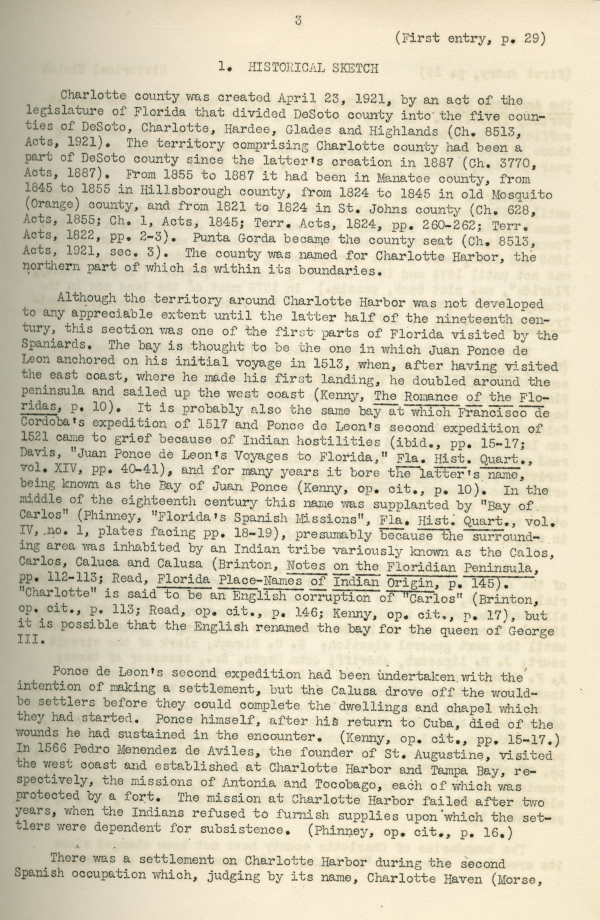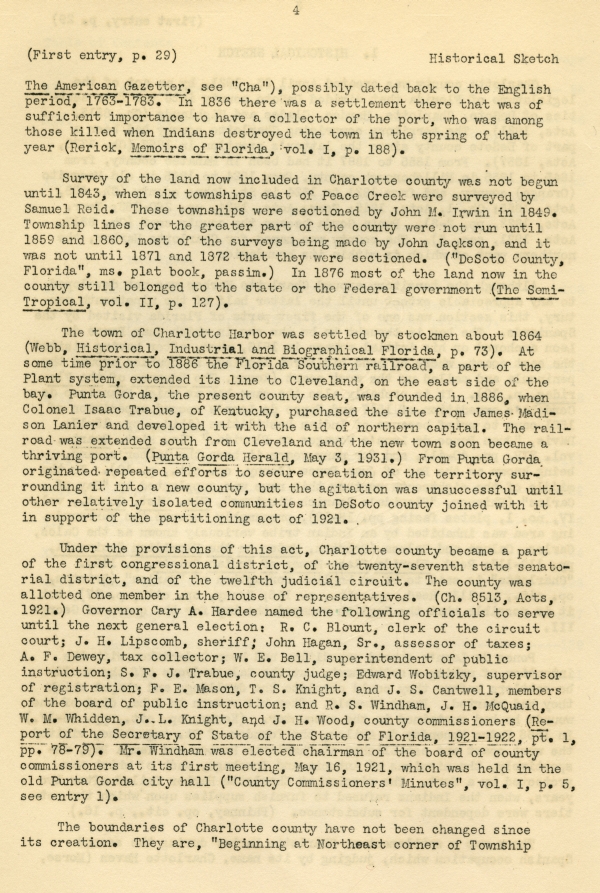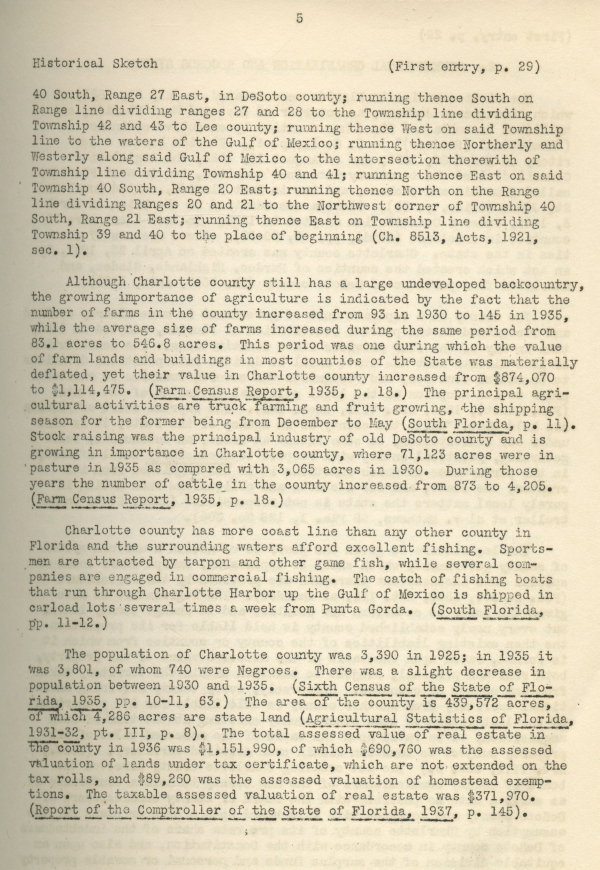3
(First entry, p. 29)
1. HISTORICAL SKETCH
Charlotte county was created April 23, 1921, by an act of the legislature of Florida that divided DeSoto county into the five counties of DeSoto, Charlotte, Hardee, Glades and Highlands (Ch. 8513, Acts, 1921). The territory comprising Charlotte county had been a part of DeSoto county since the latter's creation in 1887 (Ch. 3770, Acts, 1887). From 1855 to 1887 it had been in Manatee county, from 1845 to 1855 in Hillsborough county, from 1824 to 1845 in old Mosquito (Orange) county, and from 1821 to 1824 in St. Johns county (Ch. 628, Acts, 1855; Ch. 1, Acts, 1845; Terr. Acts, 1824, pp. 260-262; Terr. Acts, 1822, pp. 2-3). Punta Gorda became the county seat (Ch. 8513, Acts, 1921, sec. 3). The county was named for Charlotte Harbor, the northern part of which is within its boundaries.
Although the territory around Charlotte Harbor was not developed to any appreciable extent until the latter half of the nineteenth century, this section was one of the first parts of Florida visited by the Spaniards. The bay is thought to be the one in which Juan Ponce de Leon anchored on his initial voyage in 1513, when, after having visited the east coast, where he made his first landing, he doubled around the peninsula and sailed up the west coast (Kenny, The Romance of the Floridas, p. 10). It is probably also the same bay at which Francisco de Cordoba's expedition of 1517 and Ponce de Leon's second expedition of 1521 came to grief because of Indian hostilities (ibid., pp. 15-17; Davis, "Juan Ponce de Leon's Voyages to Florida." Fla. Hist. Quart., vol. XIV, pp. 40-41), and for many years it bore the latter's name, being known as the Bay of Juan Ponce (Kenny, op. cit., p. 10). In the middle of the eighteenth century this name was supplanted by "Bay of Carlos" (Phinney, "Florida's Spanish Missions", Fla. Hist. Quart., vol. IV, no. 1, plates facing pp. 18-19), presumably because the surrounding area was inhabited by an Indian tribe variously known as the Calos, Carlos, Caluca and Calusa (Brinton, Notes on the Floridian Peninsula, pp. 112-113; Read, Florida Place-Names of Indian Origin, p. 145). "Charlotte" is said to be an English corruption of "Carlos" (Brinton, op. cit., p. 113; Read, op. cit., p. 146; Kenny, op. cit., p. 17), but it is possible that the English renamed the bay for the queen of George III. Ponce de Leon's second expedition had been undertaken with the intention of making a settlement, but the Calusa drove off the wouldbe settlers before they could complete the dwellings and chapel which they had started. Ponce himself, after his return to Cuba, died of the wounds he had sustained in the encounter. (Kenny, op. cit., pp. 15-17.) In 1566 Pedro Menendez de Aviles, the founder of St. Augustine, visited the west coast and established at Charlotte Harbor and Tampa Bay, respectively, the missions of Antonia and Tocobago, each of which was protected by a fort. The mission at Charlotte Harbor failed after two years, when the Indians refused to furnish supplies upon which the settlers were dependent for subsistence. (Phinney, op. cit., p. 16.)
There was a settlement on Charlotte Harbor during the second Spanish occupation which, judging by its name, Charlotte Haven (Morse,
4
(First entry, p. 29)
Historical Sketch
The American Gazetter, see "Cha"), possibly dated back to the English period, 1763-1783. In 1836 there was a settlement there that was of sufficient importance to have a collector of the port, who was among those killed when Indians destroyed the town in the spring of that year (Rerick, Memoirs of Florida, vol. I, p. 188). Survey of the land now included in Charlotte county was not begun until 1843, when six townships east of Peace Creek were surveyed by Samuel Reid. These townships were sectioned by John M. Irwin in 1849. Township lines for the greater part of the county were not run until 1859 and 1860, most of the surveys being made by John Jackson, and it was not until 1871 and 1872 that they were sectioned. ("DeSoto County, Florida", ms. plat book, passim.) In 1876 most of the land now in the county still belonged to the state or the Federal government (The SemiTropical, vol. II, p. 127).
The town of Charlotte Harbor was settled by stockmen about 1864 (Webb, Historical, Industrial and Biographical Florida, p. 73). At some time prior to 1886 the Florida Southern railroad, a part of the Plant system, extended its line to Cleveland, on the east side of the bay. Punta Gorda, the present county seat, was founded in 1886, when Colonel Isaac Trabue, of Kentucky, purchased the site from James Madison Lanier and developed it with the aid of northern capital. The railroad was extended south from Cleveland and the new town soon became a thriving port. (Punta Gorda Herald, May 3, 1931.) From Punta Gorda originated repeated efforts to secure creation of the territory surrounding it into a new county, but the agitation was unsuccessful until other relatively isolated communities in DeSoto county joined with it in support of the partitioning act of 1921.
Under the provisions of this act, Charlotte county became a part of the first congressional district, of the twenty-seventh state senatorial district, and of the twelfth judicial circuit. The county was allotted one member in the house of representatives. (Ch. 8513, Acts, 1921.) Governor Cary A. Hardee named the following officials to serve until the next general election: R. C. Blount, clerk of the circuit court; J. H. Lipscomb, sheriff; John Hagan, Sr., assessor of taxes; A. F. Dewey, tax collector; W. E. Bell, superintendent of public instruction; S. F. J. Trabue, county judge; Edward Wobitzky, supervisor of registration; F. E. Mason, T. S. Knight, and J. S. Cantwell, members of the board of public instruction; and R. S. Windham, J. H. McQuaid, W. M. Whidden, J. L. Knight, and J. H. Wood, county commissioners (Report of the Secretary of State of the State of Florida, 1921-1922, pt. 1, pp. 78-79). Mr. Windham was elected chairman of the board of county commissioners at its first meeting, May 16, 1921, which was held in the old Punta Gorda city hall ("County Commissioners' Minutes", vol. I, p. 5, see entry 1).
The boundaries of Charlotte county have not been changed since its creation. They are, "Beginning at Northeast corner of Township
5
Historical Sketch
(First entry, p. 29)
40 South, Range 27 East, in DeSoto county; running thence South on Range line dividing ranges 27 and 28 to the Township line dividing Township 42 and 43 to Lee county; running thence West on said Township line to the waters of the Gulf of Mexico; running thence Northerly and Westerly along said Gulf of Mexico to the intersection therewith of Township line dividing Township 40 and 41; running thence East on said Township 40 South, Range 20 East; running thence North on the Range line dividing Ranges 20 and 21 to the Northwest corner of Township 40 South, Range 21 East; running thence East on Township line dividing Township 39 and 40 to the place of beginning (Ch. 8513, Acts, 1921, sec. 1).
Although Charlotte county still has a large undeveloped backcountry, the growing importance of agriculture is indicated by the fact that the number of farms in the county increased from 93 in 1930 to 145 in 1935, while the average size of farms increase during the same period from 83.1 acres to 546.8 acres. This period was one during which the value of farm lands and buildings in most counties of the State was materially deflated, yet their value in Charlotte county increased from $874,070 to $1,114,475. (Farm Census Report, 1935, p. 18.) The principal agricultural activities are truck farming and fruit growing, the shipping season for the former being from December to May (South Florida, p. 11). Stock raising was the principal industry of old DeSoto county and is growing in importance in Charlotte county, where 71,123 acres were in pasture in 1935 as compared with 3,065 acres in 1930. During those years the number of cattle in the county increased from 873 to 4,205. (Farm Census Report, 1935, p. 18.)
Charlotte county has more coast line than any other county in Florida and the surrounding waters afford excellent fishing. Sportsmen are attracted by tarpon and other game fish, while several companies are engaged in commercial fishing. The catch of fishing boats that run through Charlotte Harbor up the Gulf of Mexico is shipped in carload lots several times a week from Punta Gorda. (South Florida, pp. 11-12.)
The population of Charlotte county was 3,390 in 1925; in 1935 it was 3,801, of whom 740 were Negroes. There was a slight decrease in population between 1930 and 1935. (Sixth Census of the State of Florida, 1935, pp. 10-11, 63.) The area of the county is 439, 572 acres, of which 4,286 acres are state land (Agricultural Statistics of Florida, 1931-32, pt. III, p. 8). The total assessed value of real estate in the county in 1936 was $1,151,990, of which $690,760 was the assessed valuation of lands under tax certificate, which are not extended on the tax rolls, and $89,260 was the assessed valuation of homestead exemptions. The taxable assessed valuation of real estate was $371,970. (Report of the Comptroller of the State of Florida, 1937, p. 145).




 Listen: The Blues Program
Listen: The Blues Program
